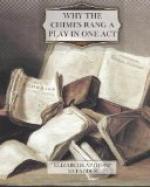[Illustration]
COSTUMES.
The costumes of this play are mediaeval, picturesque and easily constructed.—The accompanying plates will give the best idea of their general appearance. The amounts of goods required for each are noted below.
First of all, in planning the costuming for a play a definite color scheme should be decided on with due regard for the scenery against which the colors are to stand out and for the lights which will greatly affect all values. Here is an opportunity for delightful study and the exercise of the highest artistic ability. Skilful lighting and a well chosen background will make cheesecloth as effective as cloth of gold. Taste and careful experimentation not money secure the best results.
Family ragbags will often yield excellent material for theatrical costumes, and of much better quality than would be bought new for the purpose. But if the stuff is to be purchased, two materials will be found especially suitable and inexpensive. For the peasants’ costumes canton flannel is recommended as it has body and comes in beautiful dark reds, browns and other shades which light up well. For the dresses of the richer group in the chancel, sateen is best. It, too, comes in lovely colors and has a very rich glossy finish, though to give variety an occasional piece of cheap velvet or upholstery brocade is very effective. For trimming these richer garments, bits of fur or passementerie can be used, or the material may be stencilled or even painted freehand. Large gold beads sewed on in a simple design gives the appearance of rich embroidery, as do also flowers cut out of chintz and carefully pasted on.
All of the men’s jerkins or tunics are made on the simple lines of a man’s shirt, opened a little at the neck and belted in at the waist.
The most inexpensive tights for amateurs are well-fitting cotton underwear, dyed the desired color. The children and Bertel can wear their own plain soft low-heeled slippers. The rich folk in the chancel wear their own slippers and draw on over them, socks dyed to match the tights; these socks if rolled down at the top make a very passable substitute for the Romeo shoe of the period desired.
The following notes refer to the costumes of “Why the Chimes Rang” as shown in the plates, the numbers corresponding to those given the figures therein. The estimates of the amount of goods required are all calculated on the basis of yard wide goods for an adult of average size, except in the case of the two children, the costume of the older being planned for a fourteen year old boy that of the younger for a child of ten.
1. The old Woman: underrobe, cut in straight simple lines, gracefully belted, 5-1/2 yards, cloak and hood, 6 yards. If this cloak is black or nearly so it will help to conceal her entrance and exit, as black against black is practically invisible on the stage.




